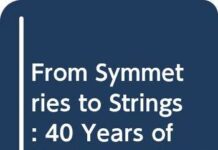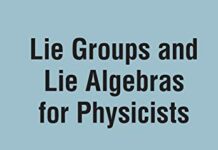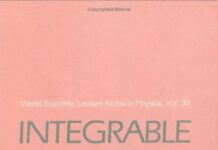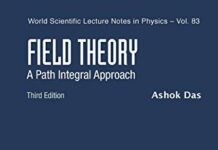
Ebook Info
- Published: 2018
- Number of pages: 852 pages
- Format: PDF
- File Size: 3.53 MB
- Authors: Ashok Das
Description
This book consists of the lectures for a two-semester course on quantum field theory, and as such is presented in a quite informal and personal manner. The course starts with relativistic one-particle systems, and develops the basics of quantum field theory with an analysis of the representations of the Poincaré group. Canonical quantization is carried out for scalar, fermion, Abelian and non-Abelian gauge theories. Covariant quantization of gauge theories is also carried out with a detailed description of the BRST symmetry. The Higgs phenomenon and the standard model of electroweak interactions are also developed systematically. Regularization and (BPHZ) renormalization of field theories as well as gauge theories are discussed in detail, leading to a derivation of the renormalization group equation. In addition, two chapters — one on the Dirac quantization of constrained systems and another on discrete symmetries — are included for completeness, although these are not covered in the two-semester course.Contents: Relativistic Equations; Solutions of the Dirac Equation; Properties of the Dirac Equation; Representations of Lorentz and Poincaré Groups; Free Klein Gordon Field Theory; Self-Interacting Scalar Field Theory; Complex Scalar Field Theory; Dirac Field Theory; Maxwell Field Theory; Dirac Method for Constrained Systems; Discrete Symmetries; Yang Mills Theory; BRST Invariance and Its Consequences; Higgs Phenomenon and the Standard Model; Regularization of Feynman Diagrams; Renormalization Theory; Renormalization Group and Equation.
User’s Reviews
Reviews from Amazon users which were colected at the time this book was published on the website:
⭐This book is very interesting, it has several points that make it unique for one’s Physicist shelf. First, it is very detailed on every calculation that it presents so that the reader can look step by step how you get to each result. Also it brings a chapter on the Dirac’s procedure to quantize a constrain system building and using the Dirac bracket as oppose to the Poisson bracket. It also has a chapter on BRST quantization, which I find is not very common. But the most important thing is that this book actually takes the incredible task of teaching you Renormalization all the way through! Yes, it talks about divergent diagrams, overlapping divergencies, trees and forest, the so called skeleton diagrams a gives you step by step the BPHZ procedure for renormalization incredible this is not easy! It even brings a brief history of renormalization that goes like this:”…..Dyson laid the foundations for the systematic study of renormalization in two papers in 1949 where he studied the renormalization of QED. He basically used the Schwinger-Dyson equations and showed that most of the divergences can be absorbed into a redefinition of the parameters of the theory. The class of graphs which he could not incorporate into his study are known as overlapping divergent graphs. Salam showed how the overlapping divergences can be handled in any theory. In QED things were a bit simpler because of the Ward-Takahashi identities and renormalization of QED was thought to be straightforward. However, Yang and Mills notice that at the 14th order!!!! (in the coupling) the photon self energy does lead to overlapping divergence and needed further prescription to handle this graph as Ward-Takahashi identities do not restrict the photon self energy (It was believed earlier that the photon self energy cannot have overlapping divergences.) Yang and Mills solved the problem of the photon self-energy and together with Salam’s work as well as the subsequent work of Weinberg, the question of overlapping divergences was considered to be solved…….”Simply Amazing stuff by amazing people: Feynman, Dyson, Salam, Yang & Mills and Weinberg the latter died just recently at age 88 on July 23, 2021.
⭐The content in the book is very good. However, the printing is not. It seems as if it was printed using gray ink. Not dark at all and can strain the eyes if it is not read in the right lighting.
⭐I did not know what happened with the printing text. The quality of the paper as well as the type of “clear/ soft printing” made it bad.I gave 5 stars because it has remarkable contents. And I hope that it has only happened to my order since I already seen a very good printing text into a friend’s book . I hope so.
⭐If you are the beginner of QFT, then I would recommend you two books: Das and Peskin. The one written by Peskin is practical and concise, whereas this one is comprehensive and well organized. You can fill up the gaps in Peskin by finding answers from this book. Highly recommend.
⭐I am learning myself QFT. I have been checking around many of the classic texts on the subject and they are either too advanced for a newcomer, or basic but still lacking in the presentation. I have a praise for QFT for the Gifted Amateur, but after reading the first 12 chapters, things start to look simple enough to try to look for a more structured approach. The famous book of Klauber is a good option, but I can’t learn with so many boxes, arrows and symbols.Then I find this book. I am reading in it now and I found how clear and with a lot of physical intuition is written. There is a single topic and does not mix 1000 cases where similar things may arise (as is the case with Klauber or Lancaster books). I am quite surprised that he introduces Dirac equation very quickly and very clearly (in other books, you may look at this equation after 243 chapters). Also, what I also liked a lot is its mathematical consistency. Compare for example the first chapters of the Schwartz book where he does not respect upstairs/downstairs indexes, and this can be an overkill, specially if you want to learn Maggiore’s excellent (but more advanced) text.
⭐This is the book you should read after an undergrad study of quantum mechanics (a previous knowledge of undergrad particle physics helps with some examples, but it’s not required). It walks you through Klein-Gordon and Dirac equations, introducing the second quantization concept in a very intuitive and practical way. It goes all the way till renormalization group, and most of the calculations are carried in a precise manner, so it’s very easy to deal with them. A must have book, one that everyone should read before specializing in their fields.
⭐I have wanted to learn Quantum Field Theory which is known to be a difficult subject. I found this book to be a gentle introduction to the subject. It is basically a compendium of classroom lecture notes. Professor Das has structured the book to enable the reader to have a bird’s eye view of the entire subject. I strongly recommend the book.
⭐El libro no es muy alto pero si ancho. Me gusta que viene justo lo que se debería ver en un curso basado en cuantización canónica, sin embargo no menciona para nada path integral, así que si estas tomando un curso de QFT basado en path integral no te servirá y en dado caso te convendría más el libro de Ashok Das de QFT basado en path integral.La mayoría de los pasos no son difíciles de seguir, aunque a veces si saca cosas que considero debería explicar más si consideramos que es un libro basado en un curso para los que se inician en el campo.El libro no esta mal pero tampoco diría que es 100% pedagógico. Me gusta que en él puedo complementar algunas ideas, demostraciones que son menos explicadas en otros libros. Sin embargo, este libro no es para aprender a hacer cálculos, es más para conocer la teoría básica detrás de todo QFT. No obstante, si esta diseñado no para mejorar en los cálculos rutinarios sino para entender la teoría de fondo, debería tener más explicaciones profundas para sentir la escencia de la QFT (aunque este punto casi ningún libro de campos lo cumple) y no las tiene, es más un libro con mucha talacha útil que en general se va entendiendo pero de vez en cuando algo puede necesitar más explicación.Mi recomendación para aprender desde cero como un recien iniciado sería leer los libros de campos en este orden (del más fácil al más difícil, divido los libros en bloques de Introductorios, Fáciles, Intermedios Fáciles, Intermedios, Intermedios Difíciles, Avanzados, Muy Avanzados(Los niveles Intermedio fáciles están basados en cursos de posgrado pero si sus cursos son como el mio podrían tener algo del nivel de intermedio, intermedio avanzado o avanzado. No obstante Student Friendly es buenisimo incluso para esos cursos. También cabe mencionar que hay libros pedagógicos diseñados para el autoaprendizaje, libros para aprender a hacer cálculos, libros para aprender más sobre la teoría de fondo o detrás de QFT (sin profundizar en como hacer cálculos), libros que son pura talacha y poca explicación, libros densos que son más útiles como libros de consulta que de autoaprendizaje, basados en cuantización canónica o en path integral, etc. Recomiendo tener un grupo de libros sencillos para aprender, intermedios para profundizar un poco más formal y difíciles para consultas y un grupo basado en cuantización canónica y otro en path integral.INTRODUCTORIOS0. QFT digestible quantum field theory (no tan necesario)1. Physics from symmetry (excelente libro, libro pedagógico de autoaprendizaje y para aprender la teoría de fondo, más basado en cuantización canónica)2. Quantum Field Theory Demystified (rápido, fácil de leer y te da una idea de los cálculos en qft pero aun te deja con dudas que se van despejando con el que sigue. Libro pedagógico de autoaprendizaje, más basado en cuantización canónica)FÁCILES3. Student Friendly Quantum Field Theory (el mejor libro para iniciarse, bien aprendido este te sacas un curso de posgrado. No te dejes llevar por su portada creyendo que no es formal, este libro vale la pena junto con su libro de solucionario. Libro pedagógico de autoaprendizaje, para aprender a hacer cálculos, profundiza en la explicación física detrás de qft, en muchas ocaciones el autor no teme en hacer toda la talacha, es un libro muy grande y con letra incomoda con apenas la cantidad de páginas aceptables para ser pedagógico, basado en cuantización canónica.)4. Quantum Field Theory for the gifted amateur (en realidad es más sencillo terminar este libro que el anterior y es pedagógico, sin embargo este libro no se acerca en nada al nivel pedagogico de student friendly, sus problemas son mas complicados, le falta explicar más algunas cosas que student friendly sí explica y trata temas más avanzados. Por eso recomiendo primero student friendly porque leyendolo entonces este otro será más fácil y le sacaras más jugo a los temas avanzados. Libro pedagógico, tiene sus primeras secciones basadas en cuantización canónica y después varias en path integral). El autor tiene otros libros muy recomendables para aprender de termo y física estadística.INTERMEDIO FÁCIL5. A first book of quantum field theory, Palash B. Pal y Lahiri (sacado de un curso de posgrado, tiene un nivel aceptable para introducirse en los temas. Es muy bueno y aquí he encontrado partrs de demostraciones que no he visto en otros libros. Es el tipo de libro que es más útil para aprender a hacer cálculos. En general los libros de Palash Pal son recomendables. Libro pedagógico, para aprender a hacer cálculos, con bastante talacha en algunas partes, basado en cuantización canónica).6. Quantum Field Theory the why, what and how de Padmanabha. El libro para aprender qft desde el punto de vista de path integral (pedagógico de autoaprendizaje, no aprendes a hacer cálculos, explica la teoría de fondo profundizando en la explicación, basado en path integral)INTERMEDIO7. A modern inyroduction to quantum field theory de Michele Maggiore. Tiene los temas que se deben ver en un curso, tiene un buen capitulo sobre grupos, simetrías y como esto se relaciona con campos, aunque es más como un resumen de lo que se aprende en physics from symmetry. El libro tiene buen formato pedagógico aunque le falta profundizar y a pesar de que tiene algunos problemas resueltos, necesitaras revisar más libros aun.8. Greiner . Este no es tan necesario leerlo9. Franz Mandl. Este no lo recomiendo tanto yo. El libro en ocaciones parece un resumen de los resultados importantes. Es un libro viejo aunque varios de los autores pedagógicos suelen recomendarlo como una referencia sencilla. Lo que sí es que trata muchos temas. No es tan necesario leerlo.10. Gauge Theories in Particle Physics vol1. de Aitchison y Hey. Muy buen libro, el autor Aitchison en general escribe bien y tiene otros libros muy recomendables como para aprender supersimetría. Libro pedagógico, de autoaprendizaje, no muy grande, para aprender la teoría de fondo y no aprendes a hacer cálculos y esta más basado en cuantización canónica.INTEODUCTORIOS DIFÍCILES11. ASHOK DAS Cuantización Canónica. Es este libro. Es bueno pero ya todo lo que mencione arriba12. Ashok das PATH INTEGRAL. Similar en estilo de escritura al anterior. Es otro buen libro basado en path integral. Sólo que antes de leerlo si recomiendo leer el libro de Padmanabha. Es un libro lleno de talacha en el que no aprendes a hacer cálculos sino que sólo trata de explicar la teoría de fondo a través de esos cálculos pero falta un poco más de explicación como palabras de la física detrás (como en la mayoría)13. Gauge Theories in Particle Physics vol 2. de los mismos autores que el vol1. Es muy parecido al vol 1 pero más complicado.14. Ryder. Un libro que no teme para nada en hacer toda la talacha y es fácil de ir siguiendo todos sus pasos y eso es algo que me gusta, esto es característico de los libros de Ryder . Suele ser recomendado también por autores con estilo pedagógico por este detalle en sus cálculos. Esta basado en path integral y otros libros del mismo autor me han sido muy útiles. Algo Pedagógico, lleno de talacha, trata temas difíciles pero es algo viejo y puede hacerse algo tedioso para terminar.AVANZADOS15. Quantum Field Theory and the standard model. El mejor libro en esta categoría. Bien explicado, útil para aprender a hacer cálculos hmaunque hay muchos detalles que no estan tan detallados como en algunas de las referencias anteriores. Además inicia de una manera distinta y esa manera no la recomendaría para un recien iniciado. Por su longitud, su manera de iniciar y su dificultad para terminarlo diría lo usaría más como libro de consulta o de apoyo para profundizar algún tema.16. Mark Srednicki. Mas difícil que el anterior. Temas o capítulos cortos como intentando ser pedagógico y bien ordenados y creo que ese es su mayor fuerte, además de que el libro esta tapizado de cálculos. Sin embargo en ocasiones se siente que falta mayor profundidad en algunos pasos y mucha más explicación de la física detrás de todos esos cálculos (porque sin eso se pierde el sentido de tanto cálculo). Por su orden, longitud total del libro, talacha y capítulos cortos lo colocaria en libros de consulta o como para un maestro que revise un tema antes de dar su clase.17. Zee. Este yo no lo recomiendo pero es recomendado por la mayoría. Pienso que el autor pretendió hacer algo similar a lo que hicieron los autores de QFT for the gifted amateur, i.e. tratar temas complicados poniendo resultados importantes sin hacer mucha talacha y platicando mucho de la física detrás de todo eso. El problema es que a pesar de que el libro es de la seromie In a nutshell, considero que no se le saca el máximo provecho hasta que ya revisamos varios libros antes con los cálculos hechos. Definitivamente como un primer libro no es recomendable y tampoco para aprender a hacer calculos pero profundiza en la teoría de fondo de QFT.MUY AVANZADO18. 19. Y 20. Los tres tomos de Weinberg. A este nivel de muy avanzado no hay ningún otro que se le acerque.Esos son los libros de mi lista y con eso cubriras todo. Nos es necesario leer todos. Quizas 1 o 2 por sección de dificultad y leer tanto libros basados en cuantización canónica como los basados en path integral. Trate de enlistar las mejores referencias, con toques lo más pedagógico posible. Libros como peskin, bailin & love, bogoliubov, baulieu, pokorski, Gross de plano no los recomendaría como libros pedagógicos para autoaprendizaje y sólo recurriría a ellos para buscar más información sobre el tema, además de que son muy viejos. Una excepción es el libro de Pierre Ramond que no se mira tan mal, de hecho parece ser muy bueno y basado en path integral, sin embargo es demasiado viejo. En mis referencias traté de basarme en referencias en su mayoría más modernas (menos el mandl) o con un tratado pedagógico.Good book for indian Universities..
⭐The author takes the reader by the hand and leads him slowly into QFT country. Sometimes the calculations get a bit repetitive, which isn’t necessarily a bad thing since it supports the learning process.
⭐Awesome
Keywords
Free Download Lectures of Quantum Field Theory in PDF format
Lectures of Quantum Field Theory PDF Free Download
Download Lectures of Quantum Field Theory 2018 PDF Free
Lectures of Quantum Field Theory 2018 PDF Free Download
Download Lectures of Quantum Field Theory PDF
Free Download Ebook Lectures of Quantum Field Theory





